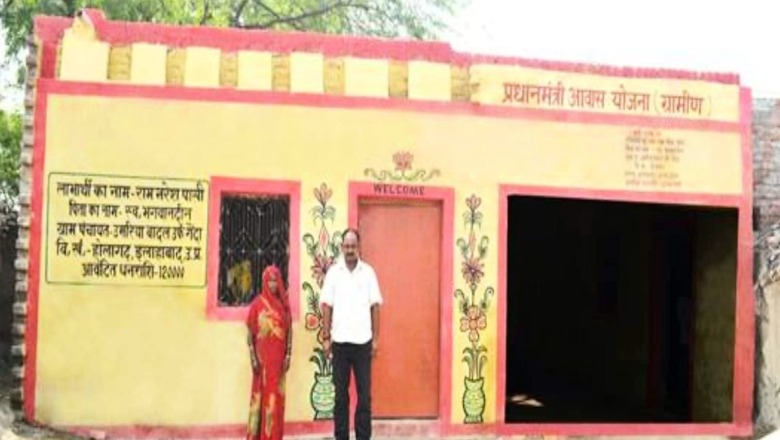
views
The Pradhan Mantri Awaas Yojana (PMAY-Gramin) was launched by Prime Minister Narendra Modi on November 20, 2016, from Agra, after detailed planning and beneficiary selection processes had all been firmed up. Since coming to power in 2014, the Modi government has constructed 29 million homes in rural India, which is a significant 6 percent of total rural households in India. This includes the nearly 7.5 million Indira Awaas Yojana (IAY) homes that were taken up between 2014-2016 and the backlog of incomplete units. This was only possible due to the adoption of Direct Cash Transfers to the verified bank accounts, the creation of the state nodal account and other reform processes that characterise PMAY-Gramin. A total of 21.35 million homes have been completed so far, of which 9.45 million (44 percent) belong to SC/STs and 2.79 million (13 percent) to minorities. Over 80 percent of homes have been constructed in some of the poorer states, regions and districts of India. Clearly, the social and regional disparities have been bridged by PMAY-Gramin.
The starting point in planning for PMAYG was to address all the critical failures of IAY, identified through an outstanding performance report of the Comptroller and Auditor General. We did not want to make the same mistake all over again and therefore began with the development of housing typologies, agro-climatic zone-wise, and soil-type wise by the best architects from the Universities. Traditional housing was studied and ways to keep the design with reinforcement to ensure safety from an earthquake, wind, flood, rains, heat, etc. were worked upon, resulting in over 200 housing designs across the country to suit the region. They were adopted by the states after an intensive and deliberative process. Detailed costing exercises were carried out to understand what is the minimum amount that would be needed to provide poor household dignity through housing. This homework helped us defend the unit cost of a total of Rs 1.5-1.6 lakh (including 90 days of MGNREGS work and SBM toilet). Electricity connection, Ujjwala gas, and drinking water connection are also being provided on priority.
Luckily, for the identification of beneficiaries of the programme, the Socio Economic and Caste Census (SECC- 2011) results had been released in July 2015. It provided complete details on the housing type, roofing material and so on. Since most households did not know for what purpose the SECC was being carried out, they were reasonably honest in their responses. The enumerators were also fair in their assessments. The SECC data was mapped Gram Panchayat-wise and the list of those with two kutcha rooms was sent across to all Gram Panchayats for ratification by the Gram Sabha. A total of 40.3 million such households had been identified by the SECC, of which 25.4 million could be validated and confirmed as being kutcha. These were given specific PMAY identities, based on the temporary identification number of the SECC 2011. An effort was made to ensure that the woman of the house was also a co-owner. Over two-thirds of homes have women as owners/co-owners.
Simultaneously, work began on a real-time monitoring system using the modern technology of geotagging of assets, bank account validation, and direct transfer to the validated bank accounts. Throughout, the approach was to use technology as a means and never an end in itself. Physical records with the name of a person geotagging beneficiary standing in front of their kutcha home with a signature were mandatory to ensure that no pucca home person gets a PMAY house. In case they got it by corruption, responsibility could be fixed on the fellow who geotagged, as physical records were also there. Well before the launch of the PMAY Gramin, the MIS was fully functional and even for the incomplete IAY homes at that time, the same rule of online payment was enforced. All district-specific accounts were closed and a single state nodal account was made functional, where both the state and Central share was credited.
Construction on this scale required trained masons and for that, a 45-day onsite approved certificate skill programme was started where thousands were trained. Rani Mistris (women masons) are also the product of these initiatives. The PMAY homes of the Divyang, widow, and the infirm, were made training sites as otherwise, they would have found it difficult to organise the construction.
Making six geotagged images mandatory, including the one before the old kutcha home, ensured full transparency from a public website. As a consequence, of the 25.4 million validated, about 20.3 million came forward for a PMAY Gramin home. There were other inter-generational new kutcha homes that had to be provided for. The survey for the same was very difficult. No one was willing to speak the truth and a large number came forward to claim housing, including many who had already got IAY homes (and had become dilapidated). Housing policy will have to define inter-generational housing entitlement or else, it will become a never-ending demand. Another nine million new beneficiaries have been identified and their homes are currently under construction, to be completed by 2024.
The partnership of state and local governments has been integral to the PMAY Gramin. 40 percent of funds come from the states in the mainland and 10 percent from the Himalayan region and the Northeastern states. The Framework for Implementation was written by seven Secretaries of State that had performed well in the housing programme. All financial management and governance improvement thrusts and capacity building had the unstinted support of the states. They were co-partners in this massive effort and the partnership was one of mutual respect. Ranking of states and districts, tracking laggard blocks, and annual prizes for performers, were all designed together. Negotiations with banks for additional funds, where beneficiaries wanted to make larger aspirational homes, were all in partnership with states. The Quarterly Programme Review Committee meetings and the unstinted hard work of Prashant, Alka, Gaya, Rajeev, Ajay, Prashant, Nagesh, and Ramakrishnan, really made a difference. It is teamwork, technology, partnerships across states and local governments, public information, direct cash transfers to validated and verified accounts, geotagging, etc, that made the difference. N.R. Bhanumurthy’s periodic evaluation of the programme, externally from the National Institute of Public Finance and Policy (NIPFP), pointing out what has worked and what has not, the Common Review Mission findings and recommendations, all added value.
Putting more money in PMAY Gramin in the Budget, therefore, is a welcome decision. Rural housing also has many useful multisectoral growth linkages. Demand for steel, cement, pipes, sanitary fittings, glass panes, etc. all go up. Jobs get created and the dignity of a poor household gets restored. It is truly a win–win for economic growth and social development.
Amarjeet is a retired civil servant who was associated with this programme in its design and implementation. The views are personal.
Read all the Latest Opinions here














Comments
0 comment